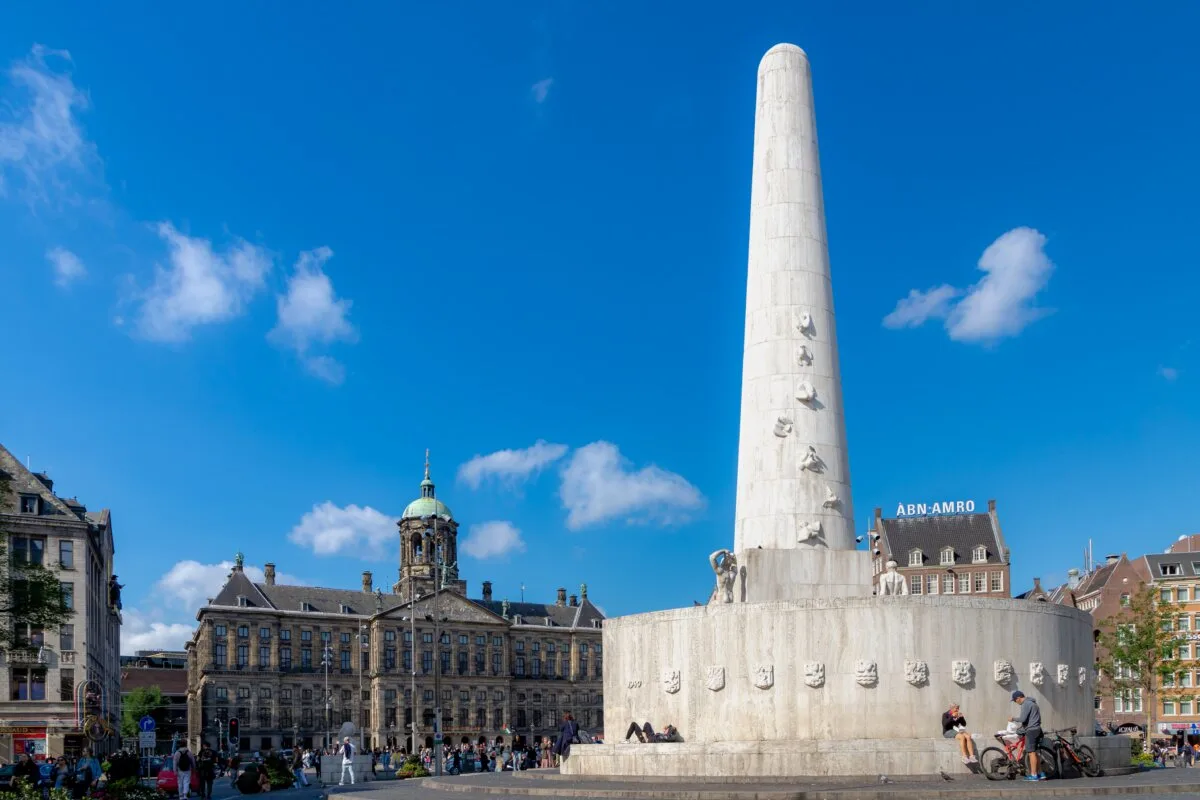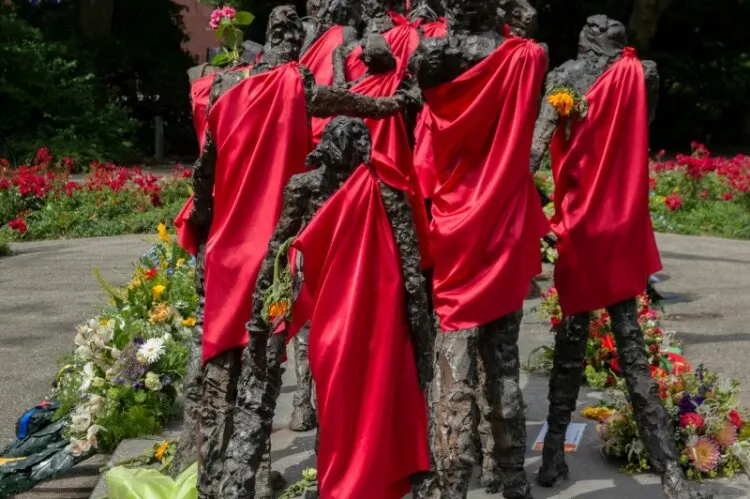The Netherlands is one of the best places to visit in all of Europe and has a ton of hidden gems of experiences throughout this tiny country. These are the most famous historical landmarks in the Netherlands.
The Netherlands is a country located in Northwestern Europe and it has landmarks that date back to thousands of years. It was once part of the Holy Roman Empire, and as such, many landmarks reflect this history.
The Dutch Golden Age began with an economic boom led by trade in Asia, which brought great wealth to The Netherlands. Many landmarks from this period remain today as reminders of how different life was during those times.
Table of Contents
Most Famous Landmarks in the Netherlands
1. Keukenhof

The Keukenhof is the most beautiful garden in the world. It is located in Holland and has lots of flowers, mostly tulips, which the Netherlands is famous for. This garden is an important example and symbol of Dutch culture.
The garden’s website says that Keukenhof is a popular tourist attraction in the Netherlands. It attracts over 800,000 people every year.
The Keukenhof Gardens are memorable because it has many kinds of flowers. The tulips are the most popular, but there are also other kinds, like hyacinths, daffodils, lilies, roses, carnations, and irises.
Keukenhof is in the “Dune and Bulb Region.” This has a warm climate. Bulbs can stay there all winter. But they only stay until summer comes.
The park is open from mid-March to mid-May, depending on the weather. When all 71 acres are covered with an incredible carpet of 8 million flower bulbs, each representing 800 distinct varieties, this is when you should visit.
According to the official website, there are 7-8 million flowers at Keukenhof each year. You can visit between late August and mid-October for a “dusk-only” experience when only the lights in the park illuminate after dark.
See Related: Best Beach Drinks for Vacations
2. Koppelpoort

The Koppelpoort is a medieval gate in the city of Amersfoort, Utrecht, Netherlands. Between 1425 and 1450, it was part of the second city wall of Amersfoort, which was built during that period.
The second wall was built to the south of the first wall that was constructed in the early 13th Century.
After having been removed, it was reconstructed about 50 years ago, and it is now mainly used as an entrance gate into a small park surrounding the castle Huis te Riviere.
See Related: Best Day Trips from Rotterdam, Netherlands
3. Castle De Haar

The De Haar Castle (Dutch: Kasteel de Haar) is located in the Netherlands’ Utrecht. It is the country’s largest castle. It was built in the Middle Ages and was used as a residence until 1926.
The present castle is surrounded by extensive (about 100 ha) landscaped parklands with walking trails open to the public. The castle’s gardens include notable Natal lilies, which bloom during July and August each year.
See Related: Best Vacations for Singles Over 40
4. Begijnhof

The Begijnhof is one of the city’s oldest hofjes. A collection of historic structures surrounds it, the majority of which are private homes. It was formerly a Béguinage, as its name indicates.
Today, there are two churches in the Houten Huys; one is Catholic, and another is Protestant, making it an essential site for Europe’s two largest Christian denominations.
See Related: Best Rooftop Tents: Top Options for 2023
5. Anne Frank House

The Anne Frank House is a writing and biographical museum dedicated to Jewish wartime diarist Anne Frank.
The Secret Annex is a 17th Century canal mansion near the Westerkerk. Anne Frank hid with her family and four others from the Nazis during the Second World War.
Her father, Otto Frank, was the only one in the group to survive and thus spent his life editing and translating Anne’s diaries to preserve her memory and the experiences of those persecuted by Nazism.
On May 3, 1960, the exhibition center opened its doors. It contains an exhibit about Anne Frank’s life and times and a permanent exhibition on all forms of persecution and prejudice.
The Anne Frank Foundation was established in the early 1970s after ten years of legal battles to prevent developers from razing the block.
Check out this amazing YouTube video about other great things to do in Amsterdam.
See Related: Best Bus Tours in Amsterdam
6. Royal Palace Amsterdam

The Royal Palace of Amsterdam, commonly known as the Prince’s House, is one of three palaces in the Netherlands that are at the monarch’s disposal by the Act of Parliament.
The palace is located on the west side of Dam Square in Amsterdam’s city center, adjacent to the War Memorial and next to the New Church.
During Amsterdam’s Golden Age, the building was one of the finest mansions in the Netherlands.
The mansion was originally a modest gabled roof structure built by Dirk van der Laan (c. 1615) on the Damstraat, later known as ‘Heere Weg’ (Gentlemen’s Route), in 1631.
7. Dom Tower

The Dom Tower of Utrecht is the tallest church tower in the Netherlands, standing at 112.5 meters (368 feet). It is regarded as the symbol of Utrecht.
The tower was part of St. Martin’s Cathedral, commonly known as the Dom Church, and was built between 1321 and 1382.
The tower has four observation platforms that provide visitors extensive views of the city. The first (lowest) platform is only accessible by stairs (no elevator or escalator).
The third observation deck may be reached with an elevator to provide spectacular town views.
8. Independence Monument Amsterdam

Between 1935 and 1938, N. Biezeveld erected the National Monument, also known as the Mast Monument or Pylon, to commemorate the Dutch Republic’s independence from Spain in 1579.
Sculptor J.W. Cremer created the two figures on top of the monument. Liberty and Justice are his work. The two figures stand on top of two symbols of the cities of Amsterdam, Delft and Hertogenbosch.
9. National Park De Hoge Veluwe

The Netherlands boasts one of the most colorful national parks in the world. The country’s largest continuously developed natural reserve is De Hoge Veluwe National Park, located in the northwest of the country.
The Kröller/Milter Museum and Museum are two of the park’s highlights, both located at the second-highest hill in the center of the park.
Dunes and woods comprise a great deal of this national park, one of the most popular tourist attractions in the Netherlands.
Approximately 2 million people visit each year to hike, enjoy cycling trails, or just roam through miles and miles of natural beauty.
The best-preserved section of the park comprises an area of dramatic dunes interspersed between heath and forest and interrupted in the south and east by moraines of up to 100 meters high.
It’s also a popular site for wildlife sightings, such as a few different types of deer species. This national park is also an excellent spot for birdwatching.
10. Waag

The Waag is one of the most crucial landmarks in the Netherlands. It was built in 1487 and has remained to be an essential landmark throughout time, even after centuries. The building served as a guild hall, museum, fire station, and anatomical theatre.
It served many purposes because it’s still standing today. One of the historical purposes that it did was as a hall for merchants who traded in wool.
Another purpose it served included being a place where people could burn their corpses after death, including famous people like Rembrandt.
11. Van Gogh Museum Amsterdam

The Van Gogh Museum in Amsterdam is a five-story building housing the world’s most extensive collection of works by Vincent van Gogh and other contemporary artists. It has been recognized as one of the world’s top art museums and attracts thousands of visitors yearly.
The permanent collection features over 200 works by Vincent van Gogh and other contemporary painters. The exhibition center features self-guided tours and group or individual guided tours of the current exhibitions.
The Van Gogh Museum continues to be one of the best museums to visit in the world. It’s located nearby a few other fantastic art museums in Amsterdam at Museumplein (or Museum Square). Other museums include the Rijksmuseum, Stedelijk, and the MOCO Museum.
12. Madurodam

Madurodam is one of the most iconic attractions in South Holland and the Netherlands.
It’s a miniature park and tourist attraction in The Hague with 1:25 scale models of Dutch buildings, historical cities, and significant developments worldwide.
Miniature Park was founded in 1952 and has continued to grow ever since. The Park covers about 2.5 hectares (6 acres) of land and has more than a million visitors annually.
13. National Slavery Monument

The National Slavery Monument is a memorial at the Oude Kerk in Amsterdam to commemorate the millions of innocent victims of slavery. It was unveiled on July 1, 2002, by Her Majesty Queen Beatrix.
The monument is dedicated to the memory of all tens of thousands of Dutch people killed or otherwise sacrificed their lives while being held in slave-like conditions in the Dutch colonies.
Along with tragic losses tens of thousands suffered while being enslaved or while resisting slavery, there are also tens of thousands who were freed thanks to their resistance.
The monument also honors the numerous contributions that these heroes have made to Dutch society following their emancipation.
14. Rijksmuseum Amsterdam

The Rijksmuseum of Amsterdam in Museumplein (Museum Square) has collected rare art and antiquities since 1809. This is considered the National Museum of the Netherlands and one of Northern Europe’s most iconic landmarks.
Exploring the museum is among the best things to do in Amsterdam. The Rijksmuseum is one of the most iconic attractions in the Netherlands. This museum has collected art since 1809, containing 5,000 paintings spread across 250 rooms. It is considered one of the world’s most famous museums.
This beautiful building is just as beautiful on the inside—how the artworks and objects are displayed is remarkable.
Some landmarks inside include Rembrandt’s Nightwatch and Leonardo da Vinci’s The Milkmaid (in which he drew a self-portrait). This museum is an essential visit for all art lovers.
15. Kinderdijk Windmills

The Netherlands is home to a plethora of magnificent buildings. But, the great windmills at Kinderdijk, which have been standing since 1892, should unquestionably be mentioned first.
They were finished as part of a larger project during their time by Dutch Waterline Management. I’m sure you’ve seen pictures of this iconic landmark of famous windmills in every piece of Dutch tourist literature.
They were built as part of a standard project for this time by Dutch Waterline Management. The windmills are a UNESCO World Heritage Site and have received seven stars from the Michelin Green Guide.
Want to see more? Check out this video tour on YouTube about visiting these great windmills.
16. I Amsterdam Sign

The I Amsterdam sign is a prominent advertising slogan and monument in Amsterdam. The letters are 4 meters (13 ft) tall, illuminated by LED lights at night, with the first I Amsterdam having a height of 9 meters (30 ft).
The sign was installed in 2007 in the Melkweg area between Central Station and Amsterdam North, next to the quarter’s riverside park. It faces northwards towards the affluent “North” quarter.
The original location was close to one end of the viaduct near Central Station, but this proved too central and too accessible for climbing. John Maas and Rob van Kranenburg designed the letters, and Adriaan Rees constructed the sign.
The sign was cast in metal and plated with thousands of glass reflectors by reflector company Zeeuws Measuurwerk as the final step in the construction of the sign.
See Related: How to Find Christian Vacation Rentals
Conclusion
The Netherlands’ landmarks are a crucial part of Dutch history and culture. They span ancient to modern times, with many functions over the years. The Dom Tower was formerly a church but is now utilized as an observation deck offering spectacular views.
The Burcht van Leiden was built in the 11th Century and has served as a military fortification or gateway into Amsterdam for centuries before becoming public parkland.
There’s also Madurodam, which features 1:25 scale models of famous landmarks worldwide, including Utrecht City Hall and I Amsterdam sign! Join our free travel newsletter and get travel tips on the Netherlands directly to your email inbox.
FAQ
What are the Netherlands ‘ most iconic attractions?
The Netherlands is renowned for the beauty of its landmarks. The country has an impressive series of canals, including Amsterdam’s famous canal belt that once infamously doubled as a moat during the Siege of Leiden (1574).
This long line of fortification is in addition to several larger-scale landmarks in Holland, including Madurodam – a miniature park in Rotterdam with hundreds of meticulously scaled versions and perfect replicas stretching for more than 40 acres.
The vast Delft Blue pottery is another Dutch masterpiece worth at least two hours per outpost.
Thousands of years ago, when sea-based trade came into being, traders would set their cargo on large boards after coming ashore. This is how Delft was born.
What is a landmark of the Netherlands?
The Amsterdams: The most iconic attractions in Europe and the Netherlands would have to be the three iconic buildings of Amsterdam: The Royal Palace, Nieuwe Kerk, and Oude Kerk.
These landmarks are all located near one another and also happen to be many centuries old, with their primary architectural styles being Gothic, Baroque, and Renaissance, respectively.
What is an essential geographic landmark in the Netherlands?
Amsterdam’s Anne Frank House is one of the most well-known landmarks in Holland. The house opened to the public in 1960, just one year after she died.
It’s located on Prinsengracht 263, where she lived for two years with her family until they went into hiding during World War II.
The house where Annie spent 178 days hidden from Nazi persecution has been preserved as a testament to human willpower, endurance, and dignity.
What are the Dutch famous for?
The Netherlands is famous for landmarks like Amsterdam’s tulip fields, the windmills of Kinderdijk (both UNESCO World Heritage sites), De Rijksmuseum in Amsterdam (one of the largest art museums in Europe).
Related Resources
